Stockrose: description, planting and care

Among perennial horticultural crops, a special place is occupied by stockrose. This plant, which many people confuse with mallow, has incredibly bright and lush inflorescences and can grow up to 2.5 meters in height. In this material, you will get acquainted with the description of the stockrose, as well as with the peculiarities of planting and caring for this garden plant.


Peculiarities
Stockrose (or Álcea) refers to flowering garden plants from the Malvaceae family. The genus of this garden culture includes 77 varieties, among which there are annuals, biennials and perennials.
Stockrose has bisexual massive flowers of regular shape... The corolla of the plant consists of 5 connected petals, and there is also a characteristic subtlety. The plant is characterized by alternate and symmetrical leaf plates of light green color, an erect, elongated stem, as well as a tap and powerful root system.
The dried fruits of this garden culture resemble brown cakes. One fruit capsule can contain from 14 to 40 brown bean-like seeds.


Depending on the age of the plant and its variety, it can grow up to 2.5 meters in height. In their natural environment, these flowers are rare. Their reproduction occurs mainly by seeds, which are carried to a new place by wind or wild animals. The flowering period of a horticultural culture lasts about 2-3 months and usually begins in late June or July.
Stockroses are grown today exclusively for decorative purposes for the sake of their bright and massive inflorescences - each bud when opened can reach 20 cm.
The inflorescences themselves are with single-row or double petals - the latter are similar to the flowers of an ordinary rose.

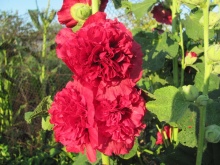

What are the differences with mallow?
Stockrose belongs to the Malvaceae family, but it is considered an independent genus, which has about 80 species. It is because of the external similarity of mallow and stockrose, as well as due to their relationship to the same family, that many gardeners do not see the difference between these plants. Below are factors that will help you understand how garden stockrose differs from mallow.
- The most important difference between these plants is growth period in a permanent place. If mallow or mallow belongs to biennial or annual plants, then stockrose may be perennial.
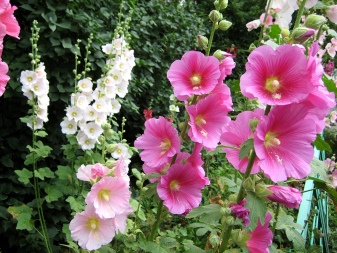
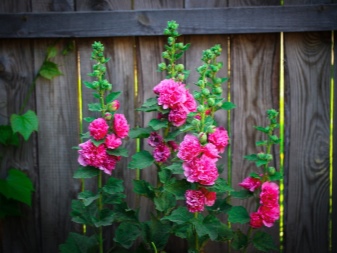
- The second important difference between stockrose and mallow is different growth rates.... For example, if mallow usually does not grow more than 120 cm in height, then stockrose can grow up to 2.5 meters. The same applies to the minimum height of these flowers - for mallow it is 30 cm, and for stockrose - 50.
It is due to the higher height that the stockroses are planted near fences or brick walls.


- Some differences also relate to specific features.... As already mentioned, the stockrose genus includes about 80 (to be more precise, 77) varieties, while the mallow genus consists of only 29 species. The natural area of distribution of these plants can also be distinguished - stockrose is considered an exclusively domesticated plant and is usually found only as a garden culture. And some varieties and types of mallow grow in the wild.


- Stockrose is a more demanding horticultural crop - it needs special preparation for the winter and, when sown, forms only rosettes without inflorescences. Mallow, in turn, does not require special preparation for winter and can bloom in the first year. In addition, both mallow and stockrose are grown by seed.
The difference in planting here is that the mallow is usually planted directly in the open ground, while the stockrose is usually planted in seedlings first.


Varieties
Today, gardeners use only 8 varieties and varieties of stockrose.
- Annual. It is a relatively low plant - up to 80 cm, with five-petal or double inflorescences up to 10 cm in diameter. The flowering period begins in June and lasts until the end of August. Besides large and bright flowers, it has a light and pleasant scent. Most often planted as part of flower beds or near hedges.

- "Royal". One of the most popular annual species. It grows up to half a meter in height and has massive double flowers up to 10 cm in diameter. Also has a pleasant, but barely noticeable aroma, blooms from July to mid-September. It is often used by gardeners in the design of vases or garden pots, but you can also find it in a flower bed.

- Summer Carnival. A two-year-old variety that grows up to 1.5 meters. Possesses large and lush double flowers in the most unusual colors: pink, white, yellow and red. The flowering period is in July and lasts until September. It is actively grown for cutting and further sale.


- "Violet". One of the tallest varieties - it grows up to 2 meters. It has huge double flowers of deep purple color. The flowering period is standard - from July to September.

- "Majoretta". A two-year-old garden variety up to 80 cm high. It has large double flowers of burgundy, chocolate, red or even black. It can bloom only a year after planting in open ground - this period falls on the end of July and lasts until October.

- Stockrose is wrinkled. It is characterized by large growth (up to 2 meters), good frost resistance, as well as relatively small petals (up to 5.5 cm) of light yellow and orange color. This is one of the oldest species of cultivated stockrose - it has been cultivated since the end of the XXVI century.


- "Mulatto". This perennial variety is distinguished by its high height, as well as very large burgundy or almost black inflorescences. Most often grown for cutting and sale.

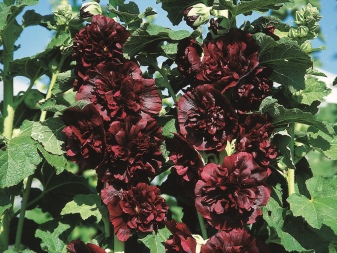
- Stockrose pink or common. This is the most common type of stockrose, from which all varieties and hybrids have gone.

How to plant?
Today, a phased scheme for planting stockroses in open ground is very popular among gardeners. It includes the timing of planting, preparation of planting material, sowing it at home, caring for seedlings, as well as transplanting seedlings into open ground.

Timing
The time of planting seeds or seedlings directly affects the length of the flowering period, as well as on plant immunity.
- The best time for planting stockroses planting material at home is the beginning of April.
- If the seeds are planted in a greenhouse in a garden plot, then the best time for this will be the first half of March.
- If the seeds are sown in open ground, then you need to choose the end of May or the beginning of June for this.
To plant seeds in open ground painlessly, they need to be planted with the arrival of warm nights and a complete absence of frost. Keep in mind that in the first year from the planted stockrose seedlings, you will not wait for flowering.

Seed preparation
Stockrose seeds, depending on the plant variety, can be harvested from mid-summer to November. Each plant has fruit in the form of capsules, which darken and turn yellow about a month after flowering - this is a sign that the seeds can be harvested. Each such box can contain from 15 to 40 seeds. If you have a stockrose variety with an autumn flowering period at your disposal, then the shoots are cut off immediately after it and dried at home.
Stockrose seeds are able to remain viable for 3 years after collection, but the best planting material is two years ago.
Before planting stockrose seeds in the ground, they need to be placed in a container with warm water for half a day. Within 12 hours, the seeds are saturated with moisture, which will allow them to germinate better in the soil.

Sowing
Stockroses, like mallows, have a taproot system; in addition, these plants do not tolerate picking well. For these reasons, deep planting containers in the form of pots or peat cups are usually used for stockroses.
For disembarkation, it is best to choose containers with drainage holes. Stockrose soil prefers nutritious and fertile - the substrate of soddy soil, peat, sand and compost will show itself best here. To make the soil even lighter and conducts air and moisture well, sawdust can be added to the substrate.


Tweezers are usually used to properly plant seeds in pots and not to harm them. The seeds should be buried no more than 1.5 cm, then they are sprinkled on top with a layer of sand or earth. To create an optimal microclimate, the container is covered from above with a film or glass and installed in a bright room with a temperature of no more than 20 degrees. The seedlings are regularly watered and ventilated. Condensation that forms on the film should be removed.
If all conditions are met, the first shoots of stockrose should appear in 1.5-2 weeks. If the plants have grown too close to each other, they should be thinned out. When planting seeds, observe the distance between them is 3-4 cm.
Many gardeners grow annual stockrose seeds at home or in greenhouses; biennial and perennial plants are usually planted directly in open ground in late spring.


Seedling care
After the shoots have sprouted, plant care does not end. In addition to regular watering and airing, they are hardened. To do this, the shelter is removed from the container every day for an ever longer period - if on the first day it is 10 minutes, then on the next day it is already half an hour. As soon as 3 full-fledged leaves appear on the sprouts, the shelter is completely removed, and the containers with sprouts themselves are exhibited every day in a cool room - on a balcony or loggia.
If the seedlings lack natural light, arrange additional light for them in the form of phytolamps. Usually, stockrose picking is not carried out - these flowers do not tolerate transplanting well and take root for a long time in a new place. If a transplant is nevertheless necessary, then it is carried out by the transshipment method - the plants are planted in a new place along with an earthen lump.
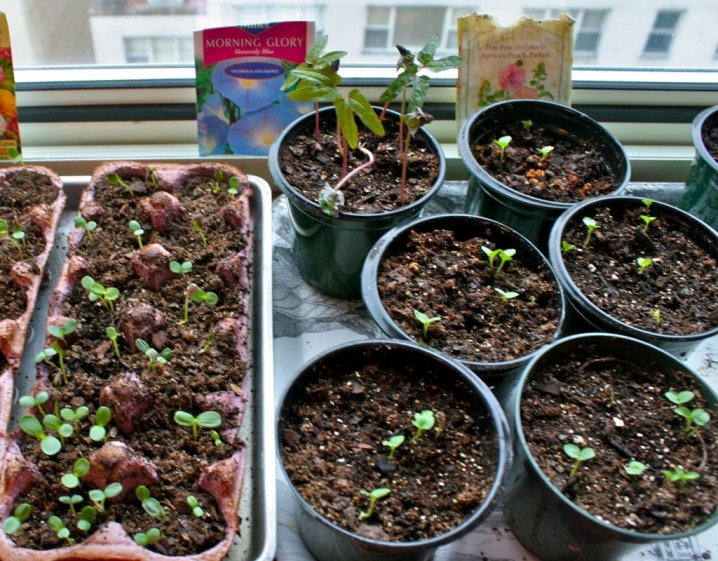
Transplant to open ground
Planting of stockroz seedlings in open ground is carried out at the end of May, with the onset of warm nights and complete warming of the soil after frosts. There are a number of factors to consider when choosing a location.
- For abundant flowering, the area for planting stockrose should be open and well lit - these plants are very fond of the sun and fade in the shade. A particular danger for flowers is a cold and strong wind, which can break their stems, and therefore it is better to plant the plant near fences or outbuildings, where they would be protected from gusts of wind.
- Only fertile and light soils with a high humus content are suitable for planting this garden culture.... The soil must conduct oxygen and moisture well, and also not interfere with the growth of the taproots of the stockrose - that is why heavy clay soils are not suitable for this. If the soil in your garden is heavy and poor, it should be dug up and fertilized with peat, sawdust and compost a week before planting the seedlings.
- After choosing the landing site and preparing the soil, the landing procedure itself takes place. To do this, deep holes are dug on the site at a distance of at least 30 cm from each other.
- Seedlings are planted in holes by transferring. The space between the earthen lump and the hole is covered with fertile soil.
After planting, the soil is compacted and watered, then a mulch layer is organized, which will retain moisture at the surface of the earth and prevent weeds from growing near the flower. It is very convenient to plant stockrose seedlings in open ground immediately in peat pots - in this case, transshipment is not necessary.


How to take care of it properly?
Caring for a stockrose includes several steps, which will not seem difficult for experienced gardeners.
- Watering. Stockroses, like all garden plants, are very fond of moisture, so the earth in their near-stem circle should never dry out. But excessive moisture for this flower can also be destructive - to remove moisture, a drainage layer of expanded clay, pebbles or broken brick must be specially organized. Watering itself is carried out once a week in normal weather, during dry periods it can be carried out every day.
Try not to flood the flowers and leaves of the plant with water during watering - this can provoke sunburn. Watering is best done in the evening or in the morning.
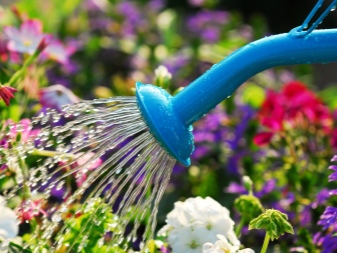

- Top dressing. Stockroses can do without feeding on fertile soil, but this flower needs fertilizers to form beautiful and lush inflorescences. Usually, fertilizing is applied to the soil to the plants 2 times. The first feeding is carried out during the planting of flowers in open ground, and the second - in mid-August, when the soil on the site is dug up and mixed with fertilizer. Mineral complex fertilizers with phosphorus and potassium are best suited for feeding. It is better to refuse fertilization with nitrogen - this will lead to the development of a large amount of greenery and reduce the number of flowers.
If you have a perennial variety of stockrose, then the flowerbed with it must be fertilized with compost or humus at least once a year.



- Support. Stockroses and mallows have very strong tap stems that can break under their own weight and the weight of the flowers. To prevent this, wooden pegs are installed in the near-stem circle near the plants (it is better if there are several of them), which are fixed to the flower with natural ropes or braid.

- Loosening. If you want to grow a healthy and beautiful stockrose, each watering of this plant must be accompanied by loosening the soil. This will allow moisture to be absorbed faster and reach the roots, and will also exclude weeds in the near-trunk circle.

Reproduction methods
Just like mallow, stockrose reproduces in two ways: seed and seedling. Each of the methods is suitable for certain varieties of this horticultural crop.
Seminal
Growing stockrose with seeds is considered the most common, although it requires more attention from the gardener. The procedure for seed propagation and planting of stockrose seeds has already been described in detail above. It is only worth noticing that perennial stockroses reproduce well by seeds and without human help. In the fall, after the flowering period, these plants scatter around themselves a lot of ready-made seeds, which go deep into the ground after the rains and germinate on their own next spring.


Seedling
The propagation of a culture with the help of seedlings is usually resorted to by gardeners who bought it in a gardening store or who want to get full-fledged flowering plants in the first year after planting a flower. The agrotechnology of planting stockrose seedlings in open ground has already been indicated above, only additional important points of such reproduction will be presented below.
- In order to plant stockrose seedlings in open ground in May, planting seeds for seedlings should be carried out in February.The planting material is planted in peat pots, which are kept until warm spring days in a ventilated, slightly darkened and cool room.
- During the transplantation of stockrose sprouts, you need to be extremely careful - there is a very high chance of harming the roots of the plant. In order for the root system to painlessly come out of the soil, the seedlings need to be watered abundantly before transplanting. When transplanting seedlings into open ground, make sure that as much soil as possible from the old pot remains on their roots.
- Avoid planting large quantities of seeds in planting containers. It is better to plant from 1 to 3 seeds in one pot. If the plants grow too thick, they thin out. In addition, the roots of closely planted shoots are very often intertwined, which can cause a lot of inconvenience when planting a crop in a permanent place.
- It is better to choose peat pots as a container for growing seedlings. They have several advantages: such pots can be planted directly into the ground without transshipment - over time they will simply dissolve in the ground; they provide passive plant nutrition during growth; peat perfectly permeates moisture and air, and fungal diseases do not develop in it. As an alternative to such pots, special peat tablets can be used for growing stockroses. They are small plates of pressed peat, which increase in size when wet.

Diseases and pests
Despite its impressive size, love for moisture and light, stockrose has a rather weak immunity against fungal diseases and garden pests.
Most fungal diseases appear from cold, excess moisture or insufficient natural light. Some viruses and diseases may already be in the soil even before the stockrose seedlings are planted in the flower bed.
The most common ailment that affects stockrose is rust. - This disease is expressed in the formation of light brown pads on the inside of the leaves. Over time, these leaves shrink, wither and fall off. To combat this disease, it is necessary to completely remove the affected leaves and treat the plant with Bordeaux mixture or Topaz. As a preventive measure, neighboring garden crops are also treated on the site with a diseased plant.




Of the pests, stockrose is very fond of aphids and spider mites... Aphids can be easily spotted by their yellow and curled leaves and by ant colonies near infested flowers. The spider mite is even easier to notice - from it the leaves of the culture are covered with a characteristic white fluff or bloom that resembles a cobweb. These insects harm the appearance of the plant and greatly weaken its immunity.


Among the most effective remedies against these pests are Akarin, Fitoferm, Tanrek, Decis, Iskra and Aktaru... If the pests have just settled on the plant and have not caused tangible harm, treating the bush with soapy water will help to cope with them.
In order not to deal with the treatment of stockrose, it is better not to allow infection at all. To do this, gardeners recommend treating stockroses with fungicides at least once a season, and for planting seedlings, take only a disinfected substrate.




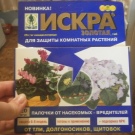

Use in landscape design
As already mentioned, today stockroses are actively grown precisely for decorative purposes - all thanks to the height of such plants and their bright inflorescences, which are able to bloom for more than 2 months... It is worth saying that these flowers can be grown both to decorate a garden plot and for a cut - often bright bouquets of stockroses can be found on the market.

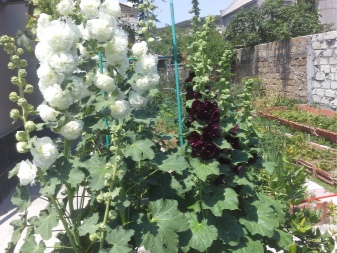
Stockrose is versatile in garden decoration. It can be planted in small groups in a flower bed, or it can grow against brick walls or fences to create a flower hedge.It is very convenient to use stockrose as a bright background for low-growing plants - in this case, it will not obscure other flowers.

In a flower bed, such plants can be successfully combined with all crops with the same rich and voluminous inflorescences. Compositions of stockrose with chamomiles, lupins, delphiniums, phlox or cuffs look best.
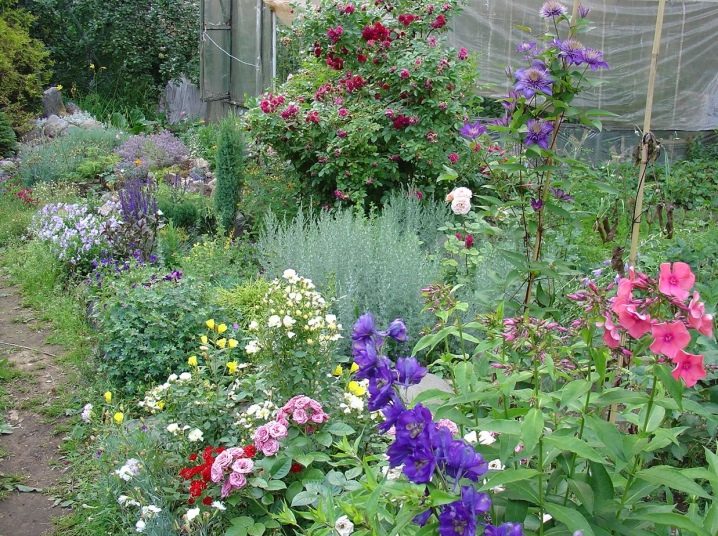
It is noteworthy that stockroses can be grown both outdoors and in large decorative pots, flowerpots or flowerpots. Stockroses can perfectly disguise outbuildings or old gazebos in the garden.


For the cultivation and care of the stockrose, see below.







































































































The comment was sent successfully.